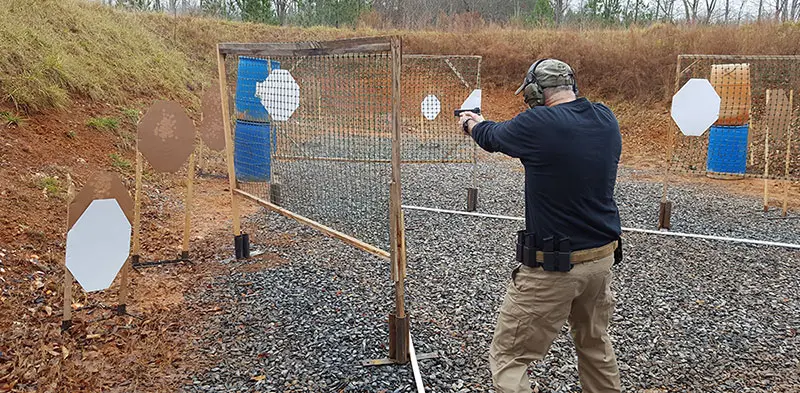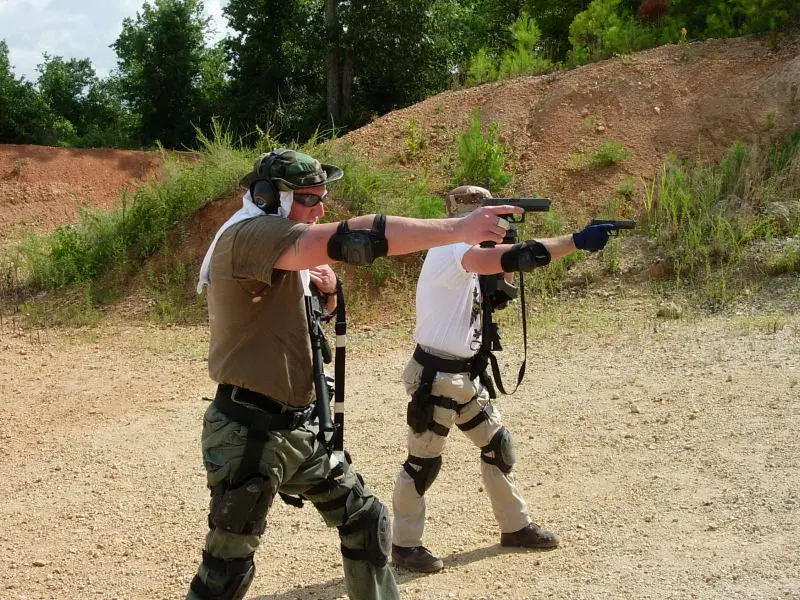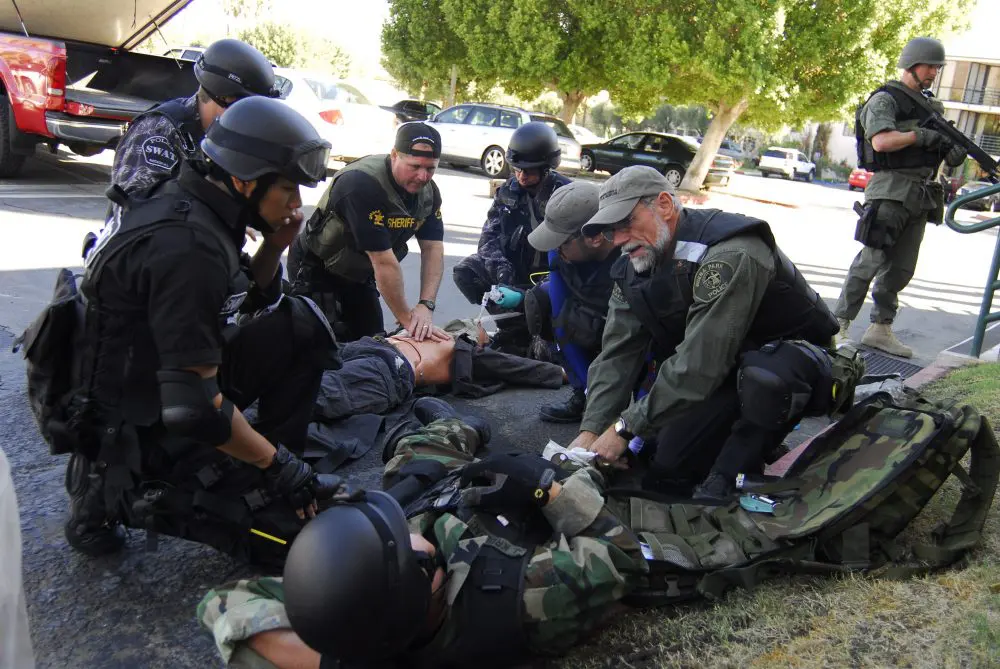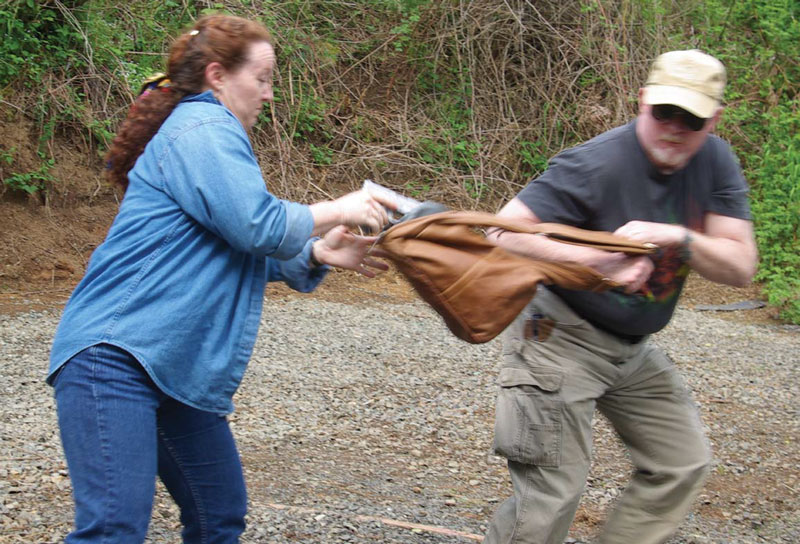

Given that many women (and an increasing number of men) do carry a firearm in a purse or go bag, which tactics work best with that carry method? How should the purse be ideally set up for an efficient draw? What are some design factors that influence the user’s defense plans? What are the practical limitations of this common carry method in use, and how can the user work around those limitations? Those were the questions five other firearms professionals and I set out to answer.
Table of Contents
THE SET-UP
We started with six participants—four women and two men. All well-trained, experienced shooters, three with extensive martial arts experience, these people agreed to spend a day exploring the best ways to set up and use purses that contain a firearm.
We planned to work with holstered purses from Coronado Leather, Galco Gunleather, Gun Tote’n Mamas, Ladies Protection LLC, The Concealment Shop, and Woolstenhulme Designer Concealed Carry. We also brought several non-holstered purses from the local Goodwill, non-firing dummy guns in various appropriate sizes, a huge pile of “purse clutter” for verisimilitude during the tests, and a long list of questions to consider.
We could not have done these tests without the manufacturers’ help. Over the past few years, these companies have provided products to me either free of charge or at drastically reduced rates, mostly for classroom demonstrations. In this way, I have acquired what may be the world’s largest private collection of holstered purses (it’s not a big field).
We also needed a place to shoot. We found it at The Firearms Academy of Seattle, a training facility in the Pacific Northwest where several of our participants and I are staff instructors.

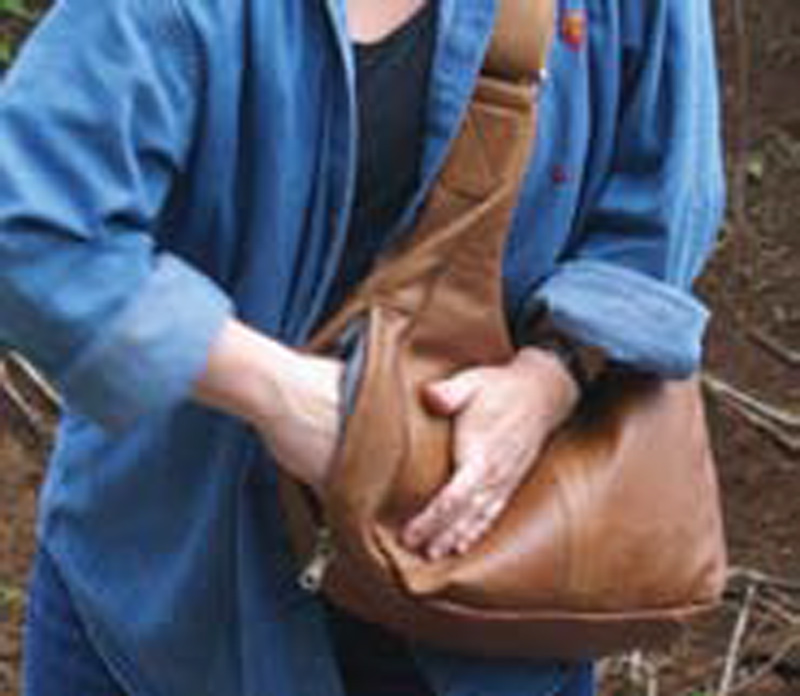
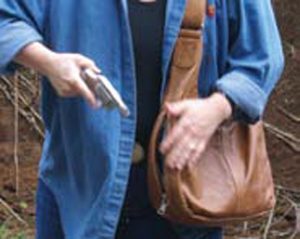

THE PURSES
Galco Gunleather makes attractive, classic horizontal-draw purses, and a few other designs. Galco purses typically feature an elastic pouch sewn into the gun compartment. This pouch is accessed through a locking zipper. Because the pouch is sewn in place, it cannot be adjusted for depth or angle, but it does provide good stability. These products also include an elastic strap to use as a retention device for the firearm. It is a rare user who sets up this device correctly (or even usably) without help from a knowledgeable person.
Coronado Leather’s purses, also typically horizontal designs with locking zippers, come with a bewildering internal holster called the “Stealth G4.” This product isn’t a holster at all, except in the very broadest sense of the word. It is an elastic and Velcro contraption designed to wrap snugly around various firearms regardless of size, hold them securely, and protect their trigger areas. It does these very well indeed. The instruction sheet from Coronado makes the wrapping process clear, but getting this holster in place inside its intended compartment can be difficult if you don’t know the trick: use the instruction sheet to prevent the Velcro from mating until you have positioned the firearm to your satisfaction.
Ladies Protection LLC (LP) and Gun Tote’n Mamas (GTM) purses usually come with a simple pouch or buckettype holster. These generic holsters fit most purse-sized handguns well enough, although smaller guns will bury themselves inside the bucket and larger ones may not fit. The Ladies Protection purse—the Slimline—provides a zippered vertical draw. GTM offers products in various configurations, and some of their purses (like the GTM-99) allow the user to choose the draw type she prefers.
The Concealment Shop has products in several different configurations. We tested the Protector—a horizontal-draw purse with a Velcro opening. Behind the Velcro seal, the opening closes with a heavy-duty snap. At first, our participants had a hard time spotting the gun compartment because the opening was so discreet and well integrated into the purse design. It proved very fast to access.
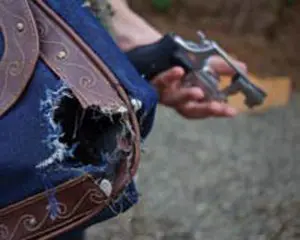
Woolstenhulme Designer Concealed Carry (DCC) bags have gone through a design change. Earlier iterations of DCC purses had loose, floppy liners in the gun compartment that made it nearly impossible to draw the gun from the sewn-in elastic holster. Realizing this, Woolstenhulme retrofitted the gun compartments with stiff Velcro and switched to a bucket-type holster. The mainstays of DCC’s product line are horizontal-draw purses with locking zippers.
WEARING THE PURSE
Are cross-body purses a smart choice for people carrying firearms? Cross-body carry has some significant lifestyle advantages. When the purse is worn rather than carried, it’s more natural to retain the purse in social settings, and the user is less likely to set it down inadvertently. It places less strain on the user’s shoulder and is secure, because the purse is not dangling from an arm or shoulder. Crossbody also carry minimizes the chance of snatching.
After watching several surveillance videos of actual purse snatchings, we discussed the issue. The driving force here was the discovery—new for some—that purse snatching is often a violent crime, a vicious assault against the person that culminates in the loss of the purse. These very sudden, very violent encounters often result in broken shoulders and concussions, and sometimes death. The more tenaciously the victim holds onto her purse, the more physical damage she endures before the attacker finally leaves. On the surveillance videos, we saw that a victim who quickly loses her purse often survives unscathed because the attacker runs off as soon as he’s gotten it. But in cases where the attacker can’t get the purse, the victim is punched, kicked, stabbed, dragged, beaten against the pavement, and sometimes left for dead.
I’m a huge fan of the deterrent effect of carrying the purse cross-body and appreciate its practical advantages in everyday living. But when that deterrent doesn’t work, you cannot let go of the cross-body purse in order to save yourself. I personally feel that protecting my own life is far more important than any secondary consideration, including the security of the gun I carry to protect my life. I would be pleased to see a purse manufacturer offering a breakaway strap on a cross-body purse.
RETAIN THE GUN, LET THE PURSE GO
We found one good draw in very close quarters that involved ignoring the purse entirely. Just focus on getting (or keeping) your hand securely on the firearm inside the compartment. The purse-snatcher takes care of the rest by grabbing the purse while you hold onto the gun, effectively “drawing” the gun for you. It’s counterintuitive but works surprisingly well.
The strategy appeared to work best when the scenario begins with the woman’s hand on the holstered gun inside the purse, such as she might do when walking through an area that makes her nervous. When starting without gun in hand, it worked much better with purses that had Velcro openings than those with zippers.
If the attacker intends a kidnapping rather than a purse snatching, the defender can still draw her firearm the oldfashioned way. She hasn’t given anything up by working to get her hand on the gun first. She also has a very clear, articulable reason for pulling the trigger, since the attacker did not try to take her belongings and run as a mere thief would do.
As a practical matter, this trick might leave you standing in a suddenly empty parking lot with a drawn gun but without cell phone, car keys, identification, or a safe place to put the gun down before the cops arrive. Better think about that ahead of time.
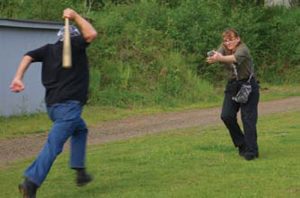
SHOOT THROUGH THE PURSE
Although I had originally set aside some of my holster purse samples as sacrificial lambs, the group decided not to shoot through this type of purse. Jennie Van- Tuyl brought up the crucial point when she said, “If the trigger is well protected inside the holster purse, as it should be, you won’t be able to pull the trigger until the gun is nearly out of the purse anyway. By the time you can touch the trigger, you’ve already drawn the gun.” And so it proved when we simulated the situation with dummy guns, so we stuck with nonholstered purses for this test.
Most experienced shooters already know this bit: you need a revolver if you want to fire more than one shot from inside a purse. Every semi-auto we tried malfunctioned after the first or (at best) second shot, but the revolvers could be fired multiple times. No surprises there.
All our participants were surprised, however, at how difficult it is to hit a close target when shooting through the purse. The shots went high, they went low, they went wide—they went everywhere except where they were supposed to go. And the target was barely outside arm’s reach.
Let me stress again that these were not inexperienced or unpracticed shooters. All of them shoot regularly and had just demonstrated their ability to hit center mass from retention position during a baseline skills check. One shooter said, “It was a lot harder than I thought it would be. The purse prevented getting a felt index and obscured the gun so you couldn’t use a silhouette of the muzzle elevation even in your peripheral vision. It was just really, really tough.”
It’s theoretically possible that with practice, a person could learn to do this skill well, but it’s hard to believe anyone would destroy enough purses to get good at it.
Our test was very unrealistic for several reasons. For safety’s sake, we did not load the purses up with any clutter that could deflect a shot, and we allowed our participants to take as much time as they needed to carefully orient the gun before they began shooting. We also used a cardboard target at a known distance, and our participants were not under stress when they fired.
DRA WING UNDER STRESS
We took a dozen purses through a modified Tueller Drill, using several different varieties of holstered designs as well as plain purses without internal holsters. The set-up placed a bad guy approximately 21 feet behind the victim, who was armed with a dummy gun. On signal, both participants began walking at a steady pace in the same direction (as if he’d followed her out of a store), then the bad guy initiated the scenario by yelling “Hey!”
As soon as the victim turned and spotted the bad guy, he began running toward her with a contact weapon. At that point, she was to reach inside her purse, acquire the dummy gun, and simulate shooting the assailant if able to do so before he reached her. And of course, she would do all this while dodging or running away if possible.
What we learned here: None of our participants were able to defend themselves adequately using a non-holstered purse design. “From a surprise ambush, there’s not much chance using a non-dedicated purse,” Diane Walls said. “I couldn’t even get the zipper open, let alone any kind of a drawstroke. That was just awful!”
Because purse carry is inherently slow, many of the zippered horizontal-draw holstered purses fared poorly in this test. But with one exception, all the holstered purses performed much better than the non-holstered purses. When working under stress, zippers are hard to get hold of, because doing so is a fine motor skill. But the small zipper problem was offset by a bigger advantage: it proved much easier to reliably find and draw the gun when it rode in a holster than when it rode loose in a plain compartment.
The clear winner during this test was the GTM-99 from Gun Tote’n Mamas. This flexible purse design allows the user to choose between a zippered horizontal, zippered vertical, or ripped vertical draw. When set up to allow the vertical rip, the purse provided the fastest and most certain draw of all the products we tested, and readily allowed our user to get the firearm out before being overwhelmed by the rushing attacker.
LESSONS LEARNED
All participants agreed that we learned some surprising lessons. One right-handed woman unexpectedly found herself using the firearm left-handed. Why? “Because that’s where I carry a purse,” she replied. There’s a lesson there. Another woman found herself shooting onehanded. Why? “I didn’t want to let go of the purse.” Again, a lesson.
At the end of the day, we walked off the range with a better grasp of purse tactics, but many questions remain. We intend to continue exploring the topic.
